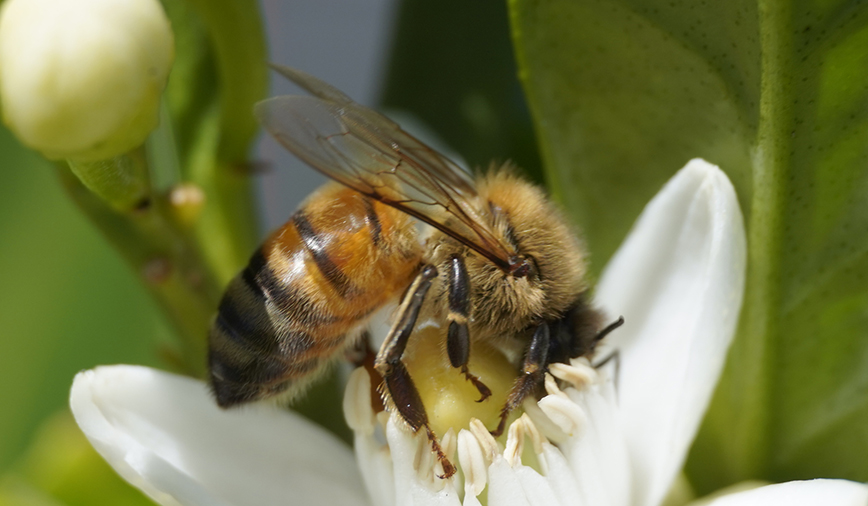March 13, 2015
Honey Bees
Have you seen me? This week’s
warmup has local honey exiting
their hives and letting go a little. Or,
actually, a lot.
The warmer temperatures we’ve had these past few days really have things
flying: Mud, as my dog Joey runs through our very moist yard. Sandhill cranes,
high in the sky, as they make their way north.
And honey bees.
Here at Hickory Knolls we are twice blessed to have not only a honey bee
tree behind our building, but also a dozen managed hives close by, in a field
southwest of the nature center.
Even though there’s still a considerable amount of snow around the ‘Knolls,
the honey bees have been making the most of the sun and warmth. After
months of being cooped up, either in the hives or the hollow of the bee tree,
it’s time to get out and let go a little.
Well, actually, let go a lot. We’ll get to that part of the story in a minute. First
though we need to take a look at what these industrious insects have been up
to throughout the long winter months.
At a time when most insects were whiling away the hours in some sort of
inactive state, be it egg, larva, pupa or adult—or just plain dead–our local
honey bees were alive and well, and living in climate-controlled comfort.
OK, maybe the term “comfort” is pushing things a little. These social insects
were working their little [honey] buns off. But for a good cause: They were
keeping their queen – the reproductive bee that ensures the colony’s future –
at summer-like temperatures as warm as 95 F.
The secret to this amazing feat lies in the bees’ ability to generate heat … by
shivering.
As humans, we tend to reach for another sweater or blanket the first instant
we feel a chill. But animals don’t have that option. In bees, the shiver is
produced in the flight muscles. The muscles that move wings up and the
muscles that move wings down contract at the same time. The results are
wings that don’t move at all, because the movements cancel each other out,
and heat, produced as a byproduct of that exertion, as energy is metabolized.
So how did the bees fuel that internal fire? With honey, of course. A decent-
sized colony of bees with, let’s say, a few tens of thousands of individuals, can
produce around 200 pounds of honey over spring, summer and fall. Just as
we store up firewood to be burned for warmth, the honeybees store up honey
to be eaten, then turned into heat.
It’s a pretty good system, darn near perfect, in fact. Except for one thing.
There’s a law of nature that states something like, “Everything that eats,
excretes,” and honeybees, sweet as they are, are no exception.
I know what you’re thinking. Surely, with their well-developed architectural
skills and advanced social system, honeybees must have some sort of
provision for relieving themselves inside the hive, right? I mean, even
chipmunks – rodents that they are – excavate little “bathroom” chambers in their burrows. Certainly a colony
sophisticated enough to have a queen would also think to have a throne.
Alas, bees have no such arrangement. Compounding matters is the strict code by which all worker bees must abide:
There’s no pottying inside the hive.
Oh my. What’s a poor honeybee to do?
The answer is deceptively simple: They hold it.
That’s right. All through the winter, as the winds whipped and the snow blew, the honeybees were inside their bee hives,
holding it.
When the gray skies dumped sleet and freezing rain, the honeybees were hanging in there, crossing their little bee
knees.
Finally, this week, the sun came out and the temperatures rose. But, oh boy golly—look out!
Like miniature bombers the honey bees emerged, intent on dropping their loads anywhere from a few to several feet
away from the hive. These trips, known as cleansing or defecation flights, produce drips – mustard-colored blotches on
the ground, on parked cars, even on the mounds of snow that remain in the shaded areas of our savanna and prairie.
Not to digress too much, but there are some researchers who believe that the cleansing flights also function as scouting
flights, during which the bees look for sources of fresh water and food. It won’t be too much longer before our wind-
pollinated tree species will be flowering. These tiny blooms will provide the bees with a much-needed supply of protein,
just the thing to rev the bees up for the coming spring.
So there you have it. Some time while the weather’s still warm—maybe even this weekend–treat yourself to a walk on
the trails at Hickory Knolls. Splash through some puddles, and take a long look at the remnants of what might be (dare I
say it?) the last snowdrifts of the season.
Do you see any yellow blotches? If so, you know for sure you’re in bee territory. Just remember (and to paraphrase the
immortal Frank Zappa):
“Watch out where the honey bees go,
And don’t you eat that yellow snow.”
Pam Erickson Otto is the manager of nature programs and interpretive services at the Hickory Knolls Discovery Center, a
facility of the St. Charles Park District. She can be reached at 630-513-4346 or potto@stcparks.org.

